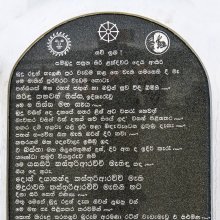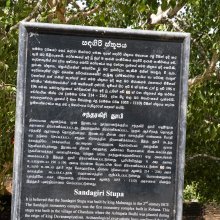Paati: 1 definition
Introduction:
Paati means something in biology. If you want to know the exact meaning, history, etymology or English translation of this term then check out the descriptions on this page. Add your comment or reference to a book if you want to contribute to this summary article.
Images (photo gallery)
Biology (plants and animals)
Source: Google Books: CRC World Dictionary (Regional names)1) Paati in Nepal is the name of a plant defined with Artemisia gmelinii in various botanical sources. This page contains potential references in Ayurveda, modern medicine, and other folk traditions or local practices It has the synonym Artemisia hedinii Ostenf. & Paulson (among others).
2) Paati is also identified with Artemisia sacrorum It has the synonym Artemisia sacrorum Ledeb. ex Hook. f..
Example references for further research on medicinal uses or toxicity (see latin names for full list):
· Southern Tibet, Botany (1922)
· Flora of India (1995)
· Dissert. De Artem. (1775)
· Bulletin de la Société Impériale des Naturalistes de Moscou (1829)
· Numer. List (3301)
· Nouv. Mém. Soc. Imp. Naturalistes Moscou (1834)
If you are looking for specific details regarding Paati, for example diet and recipes, health benefits, chemical composition, side effects, extract dosage, pregnancy safety, have a look at these references.

This sections includes definitions from the five kingdoms of living things: Animals, Plants, Fungi, Protists and Monera. It will include both the official binomial nomenclature (scientific names usually in Latin) as well as regional spellings and variants.
See also (Relevant definitions)
Starts with: Paati kanda.
Ends with: Baatule-paati, Bhotepaati, Kunju paati, Maruwa-paati, Sunpaati, Tilakapati.
Full-text (+1510): Pati, Tridashapati, Devapati, Abjinipati, Dashagramapati, Kanyapati, Shripati, Adhipati, Vikpati, Pativrata, Bhapati, Camupati, Kulatapati, Kshetrapati, Upapati, Svahapati, Patiprana, Nadanadipati, Kripipati, Khagapati.
Relevant text
Search found 107 books and stories containing Paati, Pati; (plurals include: Paatis, Patis). You can also click to the full overview containing English textual excerpts. Below are direct links for the most relevant articles:
The Buddhist Path to Enlightenment (study) (by Dr Kala Acharya)
5. The Five Mental Powers (Pañcabalāni or Bala)—Introduction < [Chapter 2 - Five Groups of Factor]
3.3. The Method of Development of Iddhi (Psychic Power) < [Chapter 2 - Five Groups of Factor]
5.5. Mental Power of Wisdom (Paññābala or Prajñā) < [Chapter 2 - Five Groups of Factor]
Rig Veda (translation and commentary) (by H. H. Wilson)
Garga Samhita (English) (by Danavir Goswami)
Verse 2.5.15 < [Chapter 5 - The Liberation of Bakāsura]
Verse 1.15.34 < [Chapter 15 - Revelation of the Universal Form to Nanda’s Wife]
Verse 1.8.22 < [Chapter 8 - Description of Śrī Rādhikā’s Birth]
Indian Medicinal Plants (by Kanhoba Ranchoddas Kirtikar)
16. Aconitum heterophyllum. Wall. < [Ranunculaceae (buttercup family)]
Rudra-Shiva concept (Study) (by Maumita Bhattacharjee)
2. Vājasaneyi-saṃhitā (h): Epithets of different beings and tribes < [Chapter 2 - Rudra-Śiva in the Saṃhitā Literature]
1. Epithets of Rudra-Śiva tracked in the Saṃhitā literature < [Chapter 6b - Epithets (References)]
3a. Rudra in the Śūlagava sacrifice < [Chapter 4 - Rudra-Śiva in the Post-Brāhmaṇic Literature]
Sivaprakasam (Study in Bondage and Liberation) (by N. Veerappan)
Introduction (The concept of God) < [Chapter 4 - Concept of God]
Concept of Self and its Intelligence < [Chapter 3 - Understanding the Self]
Chapters in the Shivaprakasham < [Chapter 1 - Introduction]
Related products




